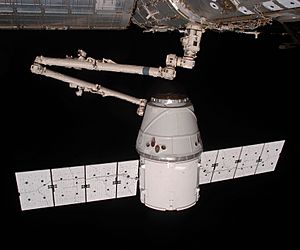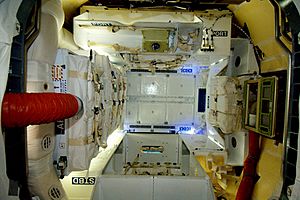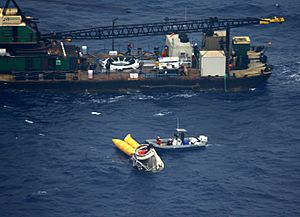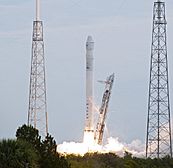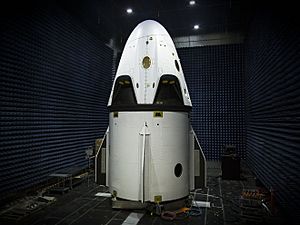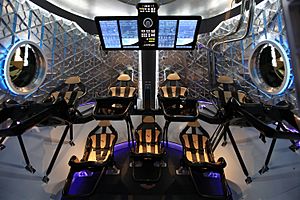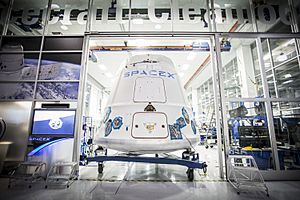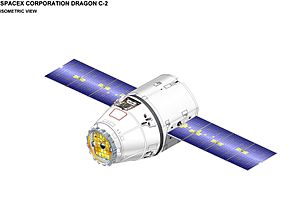SpaceX Dragon facts for kids
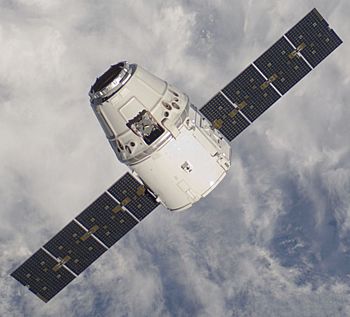
The SpaceX Dragon approaching the ISS during the C2+ mission in May 2012.
|
|||
| Manufacturer | SpaceX | ||
|---|---|---|---|
| Country of origin | United States | ||
| Operator | SpaceX | ||
| Applications | ISS logistics | ||
| Specifications | |||
| Dry mass | 4,201 kilograms (9,262 lb) | ||
| Payload capacity | to ISS 6,000 kilograms (13,000 lb), which can be all pressurized, all unpressurized or anywhere between. It can return to Earth 3,500 kilograms (7,700 lb), which can be all unpressurized disposal mass or up to 3,000 kilograms (6,600 lb) of return pressurized cargo | ||
| Crew capacity | 0 | ||
| Volume | 10 cubic metres (350 cu ft) pressurized 14 cubic metres (490 cu ft) unpressurized 34 cubic metres (1,200 cu ft) unpressurized with extended trunk |
||
| Dimensions | |||
| Length | 6.1 metres (20 ft) | ||
| Diameter | 3.7 metres (12 ft) | ||
| Production | |||
| Status | Retired | ||
| Built | 14 | ||
| Launched | 23 | ||
| Lost | 1 | ||
| Maiden launch | 8 December 2010 (first orbital flight) 22 May 2012 (first cargo delivery to ISS) |
||
| Last launch | 7 March 2020 | ||
| Related spacecraft | |||
| Derivatives |
|
||
| Dragon RCS | |||
| Fuel | NTO / MMH | ||
|
|||
| Original author(s) | SpaceX |
|---|---|
| Written in | C++ |
| Operating system | Linux |
| Platform | x86 (judge) PowerPC (actor) |
| Included with | Dragon spacecraft |
| Size | Around 100K source lines |
| Available in | English |
| Type | Application-specific system software |
| License | Closed source, internal use |
The SpaceX Dragon, also known as Dragon 1 or Cargo Dragon, was a class of partially reusable cargo spacecraft developed by SpaceX, an American private space transportation company. Dragon was launched into orbit by the company's Falcon 9 launch vehicle to resupply the International Space Station (ISS).
During its maiden flight in December 2010, Dragon became the first commercially built and operated spacecraft to be recovered successfully from orbit. On 25 May 2012, a cargo variant of Dragon became the first commercial spacecraft to successfully rendezvous with and attach to the ISS. SpaceX is contracted to deliver cargo to the ISS under NASA's Commercial Resupply Services program, and Dragon began regular cargo flights in October 2012. With the Dragon spacecraft and the Orbital ATK Cygnus, NASA seeks to increase its partnerships with domestic commercial aviation and aeronautics industry.
On 3 June 2017, the C106 capsule, largely assembled from previously flown components from the CRS-4 mission in September 2014, was launched again for the first time on CRS-11, with the hull, structural elements, thrusters, harnesses, propellant tanks, plumbing and many of the avionics reused, while the heat shield, batteries and components exposed to sea water upon splashdown for recovery were replaced.
SpaceX developed a second version called Dragon 2, which is capable of transporting humans. Flight testing was completed in 2019, after a delay caused by a test pad anomaly in April 2019, which resulted in the loss of a Dragon 2 capsule. The first flight of astronauts on Dragon 2 occurred on the Crew Dragon Demo-2 mission in May 2020.
The last flight of the first version of the Dragon spacecraft (Dragon 1) launched 7 March 2020 (UTC); it was a cargo resupply mission (CRS-20) to International Space Station (ISS). This mission was the last mission of SpaceX of the first Commercial Resupply Services (CRS-1) program, and marked the retirement of the Dragon 1 fleet. Further SpaceX commercial resupply flights to ISS under the second Commercial Resupply Services (CRS-2) program use the cargo-carrying variant of the SpaceX Dragon 2 spacecraft.
Contents
Name
SpaceX's CEO, Elon Musk, named the spacecraft after the 1963 song "Puff, the Magic Dragon" by Peter, Paul and Mary, reportedly as a response to critics who considered his spaceflight projects impossible.
History
SpaceX began developing the Dragon space capsule in late 2004, making a public announcement in 2006 with a plan of entering service in 2009. Also in 2006, SpaceX won a contract to use the Dragon space capsule for commercial resupply services to the International Space Station for the American federal space agency, NASA.
NASA ISS resupply contract
Commercial Orbital Transportation Services
In 2005, NASA solicited proposals for a commercial ISS resupply cargo vehicle to replace the then-soon-to-be-retired Space Shuttle, through its Commercial Orbital Transportation Services (COTS) development program. The Dragon space capsule was a part of SpaceX's proposal, submitted to NASA in March 2006. SpaceX's COTS proposal was issued as part of a team, which also included MD Robotics, the Canadian company that had built the ISS's Canadarm2.
On 18 August 2006, NASA announced that SpaceX had been chosen, along with Kistler Aerospace, to develop cargo launch services for the ISS. The initial plan called for three demonstration flights of SpaceX's Dragon spacecraft to be conducted between 2008 and 2010. SpaceX and Kistler were to receive up to US$278 million and US$207 million respectively, if they met all NASA milestones, but Kistler failed to meet its obligations, and its contract was terminated in 2007. NASA later re-awarded Kistler's contract to Orbital Sciences Corporation.
Commercial Resupply Services Phase 1
On 23 December 2008, NASA awarded a US$1.6 billion Commercial Resupply Services (CRS-1) contract to SpaceX, with contract options that could potentially increase the maximum contract value to US$3.1 billion. The contract called for 12 flights, with an overall minimum of 20,000 kilograms (44,000 lb) of cargo to be carried to the ISS.
On 23 February 2009, SpaceX announced that its chosen phenolic-impregnated carbon ablator heat shield material, PICA-X, had passed heat stress tests in preparation for Dragon's maiden launch. The primary proximity-operations sensor for the Dragon spacecraft, the DragonEye, was tested in early 2009 during the STS-127 mission, when it was mounted near the docking port of the Space Shuttle Endeavour and used while the Shuttle approached the International Space Station. The DragonEye's lidar and thermography (thermal imaging) abilities were both tested successfully. The COTS UHF Communication Unit (CUCU) and Crew Command Panel (CCP) were delivered to the ISS during the late 2009 STS-129 mission. The CUCU allows the ISS to communicate with Dragon and the CCP allows ISS crew members to issue basic commands to Dragon. In summer 2009, SpaceX hired former NASA astronaut Ken Bowersox as vice president of their new Astronaut Safety and Mission Assurance Department, in preparation for crews using the spacecraft.
As a condition of the NASA CRS contract, SpaceX analyzed the orbital radiation environment on all Dragon systems, and how the spacecraft would respond to spurious radiation events. That analysis and the Dragon design – which uses an overall Fault tolerance triple redundant computer architecture, rather than individual radiation hardening of each computer processor – was reviewed by independent experts before being approved by NASA for the cargo flights.
During March 2015, it was announced that SpaceX had been awarded an additional three missions under Commercial Resupply Services Phase 1. These additional missions are SpaceX CRS-13, SpaceX CRS-14 and SpaceX CRS-15 and would cover the cargo needs of 2017. On 24 February 2016, SpaceNews disclosed that SpaceX had been awarded a further five missions under Commercial Resupply Services Phase 1. This additional tranche of missions had SpaceX CRS-16 and SpaceX CRS-17 manifested for FY2017 while SpaceX CRS-18, SpaceX CRS-19 and SpaceX CRS-20 and were notionally manifested for FY2018.
Commercial Resupply Services Phase 2
The Commercial Resupply Services-2 (CRS-2) contract definition and solicitation period commenced in 2014. In January 2016, NASA awarded contracts to SpaceX, Orbital ATK, and Sierra Nevada Corporation for a minimum of six launches each, with missions planned until at least 2024. The maximum potential value of all the contracts was announced as US$14 billion, but the minimum requirements would be considerably less. No further financial information was disclosed.
CRS-2 launches began in late 2019.
Demonstration flights
The first flight of the Falcon 9, a private flight, occurred in June 2010 and launched a stripped-down version of the Dragon capsule. This Dragon Spacecraft Qualification Unit had initially been used as a ground test bed to validate several of the capsule's systems. During the flight, the unit's primary mission was to relay aerodynamic data captured during the ascent. It was not designed to survive re-entry, and did not.
NASA contracted for three test flights from SpaceX, but later reduced that number to two. The first Dragon spacecraft launched on its first mission – contracted to NASA as COTS Demo Flight 1 – on 8 December 2010, and was successfully recovered following re-entry to Earth's atmosphere. The mission also marked the second flight of the Falcon 9 launch vehicle. The DragonEye sensor flew again on STS-133 in February 2011 for further on-orbit testing. In November 2010, the Federal Aviation Administration (FAA) had issued a re-entry license for the Dragon capsule, the first such license ever awarded to a commercial vehicle.
The second Dragon flight, also contracted to NASA as a demonstration mission, launched successfully on 22 May 2012, after NASA had approved SpaceX's proposal to combine the COTS 2 and 3 mission objectives into a single Falcon 9/Dragon flight, renamed COTS 2+. Dragon conducted orbital tests of its navigation systems and abort procedures, before being grappled by the ISS' Canadarm2 and successfully berthing with the station on 25 May 2012 to offload its cargo. Dragon returned to Earth on 31 May 2012, landing as scheduled in the Pacific Ocean, and was again successfully recovered.
On 23 August 2012, NASA Administrator Charles Bolden announced that SpaceX had completed all required milestones under the COTS contract, and was cleared to begin operational resupply missions to the ISS.
Returning research materials from orbit
Dragon spacecraft can return 3,500 kilograms (7,700 lb) of cargo to Earth, which can be all unpressurized disposal mass, or up to 3,000 kilograms (6,600 lb) of pressurized cargo, from the ISS, and is the only current spacecraft capable of returning to Earth with a significant amount of cargo. Other than the Russian Soyuz crew capsule, Dragon is the only currently operating spacecraft designed to survive re-entry. Because Dragon allows for the return of critical materials to researchers in as little as 48 hours from splashdown, it opens the possibility of new experiments on ISS that can produce materials for later analysis on ground using more sophisticated instrumentation. For example, CRS-12 returned mice that have spent time in orbit which will help give insight into how microgravity impacts blood vessels in both the brain and eyes, and in determining how arthritis develops.
Operational flights
Dragon was launched on its first operational CRS flight on 8 October 2012, and completed the mission successfully on 28 October 2012. NASA initially contracted SpaceX for 12 operational missions, and later extended the CRS contract with 8 more flights, bringing the total to 20 launches until 2019. In 2016, a new batch of 6 missions under the CRS-2 contract was assigned to SpaceX; those missions are scheduled to be launched between 2020 and 2024.
Reuse of previously-flown capsules
CRS-11, SpaceX's eleventh CRS mission, was successfully launched on 3 June 2017 from Kennedy Space Center LC-39A, being the 100th mission to be launched from that pad. This mission was the first to re-fly a previously flown Dragon capsule. This mission delivered 2,708 kilograms of cargo to the International Space Station, including Neutron Star Interior Composition Explorer (NICER). The first stage of the Falcon 9 launch vehicle landed successfully at Landing Zone 1. This mission launched for the first time a refurbished Dragon capsule, serial number C106, which had flown in September 2014 on the CRS-4 mission, and was the first time since 2011 a reused spacecraft arrived at the ISS. Gemini SC-2 capsule is the only other reused capsule, but it was only reflown suborbitally in 1966.
CRS-12, SpaceX's twelfth CRS mission, was successfully launched on the first "Block 4" version of the Falcon 9 on 14 August 2017 from Kennedy Space Center LC-39A at the first attempt. This mission delivered 2,349 kilograms (5,179 lb) of pressurized mass and 961 kilograms (2,119 lb) unpressurized. The external payload manifested for this flight was the CREAM cosmic-ray detector. Last flight of a newly built Dragon capsule; further missions will use refurbished spacecraft.
CRS-13, SpaceX's thirteenth CRS mission, was the second use of a previously-flown Dragon capsule, but the first time in concordance with a reused first-stage booster. It was successfully launched on 15 December 2017 from Cape Canaveral Air Force Station Space Launch Complex 40 at the first attempt. This was the first launch from SLC-40 since the Amos-6 pad anomaly. The booster was the previously-flown core from the CRS-11 mission. This mission delivered 1,560 kilograms (3,440 lb) of pressurized mass and 645 kilograms (1,422 lb) unpressurized. It returned from orbit and splashdown on 13 January 2018, making it the first space capsule to be reflown to orbit more than once.
CRS-14, SpaceX's fourteenth CRS mission, was the third reuse of a previously-flown Dragon capsule. It was successfully launched on 2 April 2018 from Cape Canaveral Air Force Station SLC-40. It was successfully berthed to the ISS on 4 April 2018 and remained berthed for a month before returning cargo and science experiments back to Earth.
CRS-15, CRS-16, CRS-17, CRS-18, CRS-19, and CRS-20 were all flown with previously flown capsules.
Crewed development program
In 2006, Elon Musk stated that SpaceX had built "a prototype flight crew capsule, including a thoroughly tested 30-man-day life-support system". A video simulation of the launch escape system's operation was released in January 2011. Musk stated in 2010 that the developmental cost of a crewed Dragon and Falcon 9 would be between US$800 million and US$1 billion. In 2009 and 2010, Musk suggested on several occasions that plans for a crewed variant of the Dragon were proceeding and had a two-to-three-year timeline to completion. SpaceX submitted a bid for the third phase of CCDev, CCiCap.
Development funding
In 2014, SpaceX released the total combined development costs for both the Falcon 9 launch vehicle and the Dragon capsule. NASA provided US$396 million while SpaceX provided over US$450 million to fund both development efforts.
Production
In December 2010, the SpaceX production line was reported to be manufacturing one new Dragon spacecraft and Falcon 9 rocket every three months. Elon Musk stated in a 2010 interview that he planned to increase production turnover to one Dragon every six weeks by 2012. Composite materials are extensively used in the spacecraft's manufacture to reduce weight and improve structural strength.
By September 2013, SpaceX total manufacturing space had increased to nearly 1,000,000 square feet (93,000 m2) and the factory had six Dragons in various stages of production. SpaceX published a photograph showing the six, including the next four NASA Commercial Resupply Services (CRS-1) mission Dragons (CRS-3, CRS-4, CRS-5, CRS-6) plus the drop-test Dragon, and the pad-abort Dragon weldment for commercial crew program.
Design
The Dragon spacecraft consists of a nose-cone cap, a conventional blunt-cone ballistic capsule, and an unpressurized cargo-carrier trunk equipped with two solar arrays. The capsule uses a PICA-X heat shield, based on a proprietary variant of NASA's Phenolic impregnated carbon ablator (PICA) material, designed to protect the capsule during Earth atmospheric entry, even at high return velocities from Lunar and Martian missions. The Dragon capsule is re-usable, and can fly multiple missions. The trunk is not recoverable; it separates from the capsule before re-entry and burns up in Earth's atmosphere. The trunk section, which carries the spacecraft's solar panels and allows the transport of unpressurized cargo to the ISS, was first used for cargo on the SpaceX CRS-2 mission.
The spacecraft is launched atop a Falcon 9 booster. The Dragon capsule is equipped with 16 Draco thrusters. During its initial cargo and crew flights, the Dragon capsule will land in the Pacific Ocean and be returned to the shore by ship.
For the ISS Dragon cargo flights, the ISS's Canadarm2 grapples its Flight-Releasable Grapple Fixture and berths Dragon to the station's US Orbital Segment using a Common Berthing Mechanism (CBM). The CRS Dragon does not have an independent means of maintaining a breathable atmosphere for astronauts and instead circulates in fresh air from the ISS. For typical missions, Dragon is planned to remain berthed to the ISS for about 30 days.
The Dragon capsule can transport 3,310 kilograms (7,300 lb) of cargo, which can be all pressurized, all unpressurized, or a combination thereof. It can return to Earth 3,310 kilograms (7,300 lb), which can be all unpressurized disposal mass, or up to 3,310 kilograms (7,300 lb) of return pressurized cargo, driven by parachute limitations. There is a volume constraint of 14 cubic metres (490 cu ft) trunk unpressurized cargo and 11.2 cubic metres (400 cu ft) of pressurized cargo (up or down). The trunk was first used operationally on the Dragon's CRS-2 mission in March 2013. Its solar arrays produce a peak power of 4 kW.
The design was modified beginning with the fifth Dragon flight on the SpaceX CRS-3 mission to the ISS in March 2014. While the outer mold line of the Dragon was unchanged, the avionics and cargo racks were redesigned to supply substantially more electrical power to powered cargo devices, including the GLACIER freezer module and MERLIN freezer module freezer modules for transporting critical science payloads.
Variants and derivatives
DragonLab
SpaceX planned to fly the Dragon spacecraft in a free-flying configuration, known as DragonLab. Its subsystems include propulsion, power, thermal and environmental control (ECLSS), avionics, communications, thermal protection, flight software, guidance and navigation systems, and entry, descent, landing, and recovery gear. It has a total combined upmass of 6,000 kilograms (13,000 lb) upon launch, and a maximum downmass of 3,000 kilograms (6,600 lb) when returning to Earth. In November 2014, there were two DragonLab missions listed on the SpaceX launch manifest: one in 2016 and another in 2018. However, these missions were removed from the manifest in early 2017, with no official SpaceX statement. The American Biosatellites once performed similar uncrewed payload-delivery functions, and the Russian Bion satellites still continue to do so.
Dragon 2: Crew and Cargo
A successor of Dragon called SpaceX Dragon 2 has been developed by SpaceX, designed to carry passengers and crew. It has been designed to be able to carry up to seven astronauts, or some mix of crew and cargo, to and from low Earth orbit. The Dragon 2 heat shield is designed to withstand Earth re-entry velocities from Lunar and Martian spaceflights. SpaceX undertook several U.S. Government contracts to develop the Dragon 2 crewed variant, including a Commercial Crew Development 2 (CCDev 2) - funded Space Act Agreement in April 2011, and a Commercial Crew integrated Capability (CCiCap) - funded space act agreement in August 2014. The phase 2 of the CRS contract uses the Dragon 2 Cargo variant lacking cockpit controls, seats and life support systems.
Red Dragon
Red Dragon was a cancelled version of the Dragon spacecraft that had been previously proposed to fly farther than Earth orbit and transit to Mars via interplanetary space. In addition to SpaceX's own privately funded plans for an eventual Mars mission, NASA Ames Research Center had developed a concept called Red Dragon: a low-cost Mars mission that would use Falcon Heavy as the launch vehicle and trans-Martian injection vehicle, and the SpaceX Dragon 2-based capsule to enter the atmosphere of Mars. The concept was originally envisioned for launch in 2018 as a NASA Discovery mission, then alternatively for 2022, but was never formally submitted for funding within NASA. The mission would have been designed to return samples from Mars to Earth at a fraction of the cost of NASA's own sample-return mission, which was projected in 2015 to cost US$6 billion.
On 27 April 2016, SpaceX announced its plan to go ahead and launch a modified Dragon lander to Mars in 2018. However, Musk canceled the Red Dragon program in July 2017 to focus on developing the Starship system instead. The modified Red Dragon capsule would have performed all entry, descent and landing (EDL) functions needed to deliver payloads of 1,000 kilograms (2,200 lb) or more to the Martian surface without using a parachute. Preliminary analysis showed that the capsule's atmospheric drag would slow it enough for the final stage of its descent to be within the abilities of its SuperDraco retro-propulsion thrusters.
Dragon XL
On 27 March 2020, SpaceX revealed the Dragon XL resupply spacecraft to carry pressurized and unpressurized cargo, experiments and other supplies to NASA's planned Lunar Gateway under a Gateway Logistics Services (GLS) contract. The equipment delivered by Dragon XL missions could include sample collection materials, spacesuits and other items astronauts may need on the Gateway and on the surface of the Moon, according to NASA. It will launch on SpaceX Falcon Heavy rockets from LC-39A at the Kennedy Space Center in Florida. The Dragon XL will stay at the Gateway for 6 to 12 months at a time, when research payloads inside and outside the cargo vessel could be operated remotely, even when crews are not present. Its payload capacity is expected to be more than 5,000 kilograms (11,000 lb) to lunar orbit. There is no requirement for a return to Earth. At the end of the mission the Dragon XL must be able to undock and dispose of the same mass it can bring to the Gateway, by moving the spacecraft to a heliocentric orbit.
List of vehicles
| Serial | Name | Type | Status | Flights | Time in flight | Notes | Cat. |
|---|---|---|---|---|---|---|---|
| C101 | N/A | Prototype | Retired | 1 | 3h, 19m | On display at SpaceX's headquarters. | |
| C102 | N/A | Production | Retired | 1 | 9d, 7h, 57m | On display at Kennedy Space Center Visitor Complex. | |
| C103 | N/A | Production | Retired | 1 | 20d, 18h, 47m | . | |
| C104 | N/A | Production | Retired | 1 | 25d, 1h, 24m | . | |
| C105 | N/A | Production | Retired | 1 | 29d, 23h, 38m | . | |
| C106 | N/A | Production | Retired | 3 | 97d, 3h, 2m | . | |
| C107 | N/A | Production | Retired | 1 | 31d, 14h, 56m | Used for CRS-5. | |
| C108 | N/A | Production | Retired | 3 | 98d, 18h, 50m | . | |
| C109 | N/A | Production | Destroyed | 1 | 2m, 19s | Destroyed upon impact with the ocean after the in-flight explosion of the Falcon 9 first stage during CRS-7. | |
| C110 | N/A | Production | Retired | 2 | 65d, 20h, 20m | . | |
| C111 | N/A | Production | Retired | 2 | 74d, 23h, 38m | . | |
| C112 | N/A | Production | Retired | 3 | 99d, 1h | . | |
| C113 | N/A | Production | Retired | 2 | 64d, 12h, 4m | Final Dragon 1 capsule produced. Used twice for CRS-12 and CRS-17. |
See also
 In Spanish: SpaceX Dragon para niños
In Spanish: SpaceX Dragon para niños




